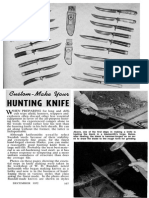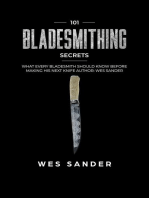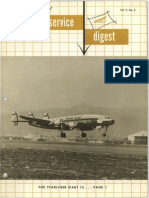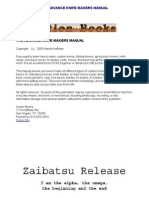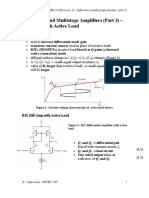34 Knife Design
34 Knife Design
Uploaded by
salenka71Copyright:
Available Formats
34 Knife Design
34 Knife Design
Uploaded by
salenka71Copyright
Available Formats
Share this document
Did you find this document useful?
Is this content inappropriate?
Copyright:
Available Formats
34 Knife Design
34 Knife Design
Uploaded by
salenka71Copyright:
Available Formats
Knife Design
"The glare of the morning sun Deep snow on the peak The sky brightens Rivers of mist around Fuji defy description" Koetsu
A swords design depends on its intended function, the cultural context from which the weapon arises and the tools, materials, working methods and proclivities of its maker. Considering all swords are required to perform the same basic functions, cut, thrust, parry and block, it seems surprising at first that thay should be so varied in design, both throughout time and across cultures.
Most peoples exhibit quite a variety of form in blade design. In the Philipines for example the variety of blade shapes is mind numbing. The Japanese on the other hand explored one form only and relentlessly persued perfection through a thousand permutations.
The progenitor of the modern katana, the tachi, was designed as a saber to be used by mounted archers who fought in the model of the Mongol. The tachi was used as a back up weapon after the archer's arrows were discharged.
1 / 10
Knife Design
As with down. most It cavelry was also sabers lighter the in tachi crossection has destinct than the curvature, modern generous katana. length and is suspended Changes led heavier. was edge to shortened up a sword Fighting in inorder battle called somewhat. that on tactics foot an the uchigatana. became around draw Rapid and 1400AD deployment more cut Due could prevalent to brought changes be ofthe made the so about weapon the in in armour sword a a revolution single became lost the fluid a blade in little a movement. design priority became of its that so curvature it marginally eventually was worn and unchanged sword end to product the since. extent of This all that this "shinto" to was the casual what or new we observer, sword now call retains the two katana, the forms characteristics which are not has readily remained of the distinguishable. "koto" fundamenally or old either The design side. Around of the blade these is parameters deceptivly simple. of course Single we find edged, a host moderately of variations. curved with a ridge line
2 / 10
Knife Design
Fig 1. alone In order is to not help sufficient describe to describe these variations the Japanese Japanese sword. terms are used as as English which The thrusting. of was blade. point essential. Swords Invariably or kissaki were is when the generally most swords important wielded are of equal at part arms of length, any length sword, most so cutting contact even those and was trenchancy not with designed the final at the inch for point or so Kissaki points such trade medium as off penetrate are the or on "chuof penetration. lamellar very soft kissaki", sturdy plate materials Point design probably armour length efficiently, and of reflects feudal also come but effects most Japan. inare many peoples suseptible cutting Shorter types ability. recognition based points to damage The on by most shape contrast ofwell against these common and fare trade harder size. better varient, offs. Longer materials but
3 / 10
Knife Design
Fig 2 Edge Fig thrusting Yeah 2 Another curvature I know while and it's must varient the of aor bit the curved have dry.! "ikari kissaki been edge kissaki" also a favours nightmare effects offered cutting. cutting to greatly resheath. Note and improved "fukura penetration. So I the thrust -hallmark cutting kareru" A I spine make straight to and the my "fukura detriment edge point,(--grin--). favours -quality. tsuku" of in classified Another feature separately of the from kissaki the hamon is the temperline proper and at its this descriptions part of the are blade. based Called on shape the boshi, and itsize. is blade. real. "virtual" "yakote" Nevertheless This or actual, line is the is established second it frequently is an important point. indistinct by carefull feature line polishing which of the separates kissaki and its as presence it the helps kissaki is to often define from more the it and rest cosmetic provides of the than a, extending guy final the head sword with sword's few one the inches is from it's relatively longest cutting point. its cousin blade, If edge stick such safe. the the and wins, were But extension spear. it's the right!. the support edge Against case While of of structure a the a 3 as a sword inch cutting spear, mentioned blade the blade edge once spine on is earlier, from inside a are different end point not the most of simply arc to a proposition. cuts grip stick described a were is means would what made by separates suffice. of the with spear The the The almost same cutting by full the hard edge "yakiba", steel, "ha" clearly the is differentially the contrasting most visually hardened with arresting the edge softer feature is steel one of of the the Japanese of a and sword's separated sword. Formed from of
4 / 10
Knife Design
Fig 3. Steel deliniating eternal in related literally identified. a known student their becomes to functional trade to "edge exist. of An "yakiba" his, off example aesthetic name", brittle between with characteristics are a on the of fair not whim hardening this shape hardness degree simple of is the of were cosmetic of the but "sanbonsugi" and smith. reliability. produced yakiba will toughness. This not in being nature hold Over is in form reflected a Yakiba, an one wide 200 but which edge of different part variety in the despite when can the of ways the use be of variations annealed. form being Japanese attributed in of which the mostly more term on The the to solution yakiba or but "hamon" Kanemoto, smith "ha" less not and are to identical was entirely that its or Features characteristics visible tendancy on of to the the reduce surface of "yakiba" the the blade as development such thin and points as should "ashi", of of martensite be longtitudinal ie. noted "lightening as extending they fractures. strikes" are toward an do indication however the edge. of affect quality. They the have These functional a are Smiths hamon free and developed could wild. be produced such a high at will. degree While of some control forms over were the heatreating restrained and process formal, that others complex were "Utsuri", complex who can, bright hardening find it cloudy a haphazard proceedures. areas of and cementite, elusive Few modern phenomonon. on the smiths upper can ji, are produce also a such note effects worthy and indication even those of shock No effort resistance. was spared These in the laminations persuit of are the visible ideal sword. on close Lamination examination was of employed the "ji". Fig to increase 4.
5 / 10
Knife Design
Fig4. Most all Handmade expedience Japanese are manifest homogenous was swords paramount. as were subtle blades laminated, water Such were marks blades especially also on were made the quite surface factory during servicable. made of this a of period well blades polished and of before, the blade. "Showa especially However, period" when not crucibles. One Thus blades smith they were These were made not therefore, laminated rounds acommon point looked of not but the mechanical were fact rather that forged like his damascus a swords from bran high/low muffin. were but made the carbon true from rounds "Damascus" imported cast Wootz in of enclosed legend. from Such clay India. Not varying appearance process perhaps carbon, and "makuri-gitae", content shape carbon rather is the still as with of most it used like a Fig content happens. the blade wrapping 5 in foregoing the sized in their This manufacture involved a bimetal slice most "sandwich" constituent of Smiths wrapping strip bread of comprising Japanese was parts. adopted around athen piece In its pounded a kitchen the of of piece simplest high practice high knives carbon carbon into cheese form of the today. forging this and steel shape and might low Another around sandwiches about of carbon take a blade, the the form the steel. same low with and This size
6 / 10
Knife Design
Fig 5. ifin then Carried single all five blade. were tocan it's combined Each ultimate ofdesign these conclusion inbreak a single grades as block were many from folded aswhich five independantly different the blade grades was to some forged. of risers steel thousands might be ofused layers a One performance. aspect of blade often overlooked is the effect that stress can have on gradual. Rapid sufficient changes fracture in crossection or lead the blade. to a buildup Such of changes stress at in crossection these transition should points be minimised which and
7 / 10
Knife Design
Fig 6. Hold until graphic blade. minimised might novel fact somewhat serve the center prevented third the the a manner. otherwise better A of pencil reminder weakest pencil diamond note rotation from are buttressed ifon in worthy situated situated It breaks. falling your be. is part that as behind also The the fist feature of the by out. closer Most about the a sword as Japanese the the area Japanese you heaviest of grip. of guard. to an of pivots the the might the inch transition, I noting time sword must Japanese butt. This blade part forward in a the knife. say But of may is is pencil the hand. around the the here typically of sword Now have blade. only this area that Of will pull the something area is form course it around break Contrast I've that back is guard and situated to always the where address it on the is so also to notches this the are peghole, do felt on it ensures point with most with leaves less this the that as the keeping second, problem with critical stressed the well and that your Philipino your peg as that the part fist. the or being in hole than other is peg sometimes such of This kris. peg inside would any they is hand a in is In and the a While we are the tang its worth the length, curvature, and taper of same.
8 / 10
Knife Design
Fig 7. As can but cut 1/4 down generally and be a versions 1/3 seen speaking of in blade Fig of same. 7 length all top can The row, for belower a nakago considered katana row or length shows tang a derivative come sword. tang in end quite ofshapes. theaubu variety Tang form of being length shapes for is and between the most sizes, a part
9 / 10
Knife Design
Fig 8. Blade thickness width but affects 2" wide acuity. could A be 1/4" quite thick sharp. blade only 3/8" wide is not very sharp. The same without The at the A. direction angle The any angle at extra the which at blade weight B a is blade is smaller penalty. moving. cuts, because affects It Therefore also the yields the width curving way more it of cuts. a the edge sword The blade per wedge is blade is one effectively way angle extension. to at get greater, B, a fig sharper 8, by is virtue less edge than of To described choice weilder. curvature facilitate length for This by a of withdrawal, purely is the especially arm withdrawing cutting from ideally so sword. the of hand. hand the shinto In curvature to This practice period the is spine. the however of swords. circumferance a At sword least Many the should this radius swords would of be a is circle based closer will seem be the on to to found radius the the be the height curve to of have logical which of a the dual is withdraw longer length since comfortably of the weilder sword and is it directly mounted must not related and touch therefore to when the height swung farther of at from its the wielder. the ground. ground. It must Tachi be can short afford enough to be to Grooves crossection, forged aligns forging. for alteration identified shinto groove the rather Over in by period for structure it the the examining is repair, than 50% carved, shinogi strength/weight swords. carved of of lightening, grooved the ji if the area the Working into steel grain layers of Koto the or like a ratio on at blade. practices blade the period follow the is layers considerably inside request lighten Forged the swords are curve of of obscured it of a grooves the and were onion, their of groove. improved. improve the carved current the are by grove somewhat fibers If superior flexibility. the while owner. Generally it is layers following forged. the Carved frequent, Because carved figure intersect the grooves grooves is as direction after closer of the the the inside were the forging can to I beam of fact, 80% be Fullered improved. enhanced. fullering small blades As Even long blades. irrespective with as the they effect are of properly length of leverage have constructed better removed, strength/weight and there designed is still a ratios handling decided and and advantage flexibility performance is to also are Cultures ribbed beam. strong It crossections. and is from also its Turkey also light gratifyingly and The to the sturdy Chora Philipinesand light and points to a the joy to the poor to Europe handle. efficacy sod to who An Africa of Arab has this made design to bayonet drag blades and it all Ito have is over with in effect, is single creation. both half and flexibly an double I and and dependability Marples Ideal made huntimg it very knife popular. is not simply a throwback to the bayonet. Its strength handling The effect Boye of leverage Basic would is eliminated be too heavy as the and weight unweildy reduction without is inside its I beam the grip. construction and here the Not lengths? all made Philipines blades of for these multiple frequently the The exquisite faint methods solutions alloy of show heart, laminations composites to offered varying composite this blade here degrees were from construction making!. are prefolded effected not from unique Breakage time by billets methods the to time. inclusion which Japan. was also. The a were Other problem, of Vikings layers later cultures forged and why of nickle. early else have into go Germans Philipine used blades. to such some In the or Swedish Check tri-laminated out and the by Finish Finish the Sandanavian cutlers pukko regularly next time cutlers sandwich in opportunity more high recent carbon arises. times. steel Stainless between steel two is layers also being of low. be also power stainless over contribution quite hammers looked. for prevalent mechanical In and that particular in hydraulic American the damascus US the among presses, cutlers rediscovery and custom have great composite made of makers. pressures Wootz. to are the And Oh feasible. are "rediscovery" joy!. now attainable, The that These use some of are so of lost cutlers that "Zone heady processes laminations tempering" are times! using cannot of is
10 / 10
You might also like
- Bang and Olufsen Beosound 3000 Service ManualDocument68 pagesBang and Olufsen Beosound 3000 Service ManualCarlo100% (1)
- Pocketknife Making For Beginners PDFDocument114 pagesPocketknife Making For Beginners PDFAlan MassingNo ratings yet
- 101 Knife Designs - Practical Knives For Daily Use - Carter, Murray PDFDocument272 pages101 Knife Designs - Practical Knives For Daily Use - Carter, Murray PDFJd Diaz100% (4)
- Sample 1 - TQDDocument15 pagesSample 1 - TQDbluuu1331No ratings yet
- Goddard Wayne - Wayne Goddard S $50 Knife ShopDocument160 pagesGoddard Wayne - Wayne Goddard S $50 Knife ShopederupfNo ratings yet
- Shirataka Chefknives MakingDocument16 pagesShirataka Chefknives MakingAvraham Eisenberg100% (1)
- Blacksmith Knife TutorialDocument18 pagesBlacksmith Knife TutorialAndre Balen100% (2)
- Pocketknife Making For BeginnersDocument114 pagesPocketknife Making For BeginnersMary Robles100% (18)
- Knife Making ProcessDocument18 pagesKnife Making ProcessPinjaman Peribadi67% (3)
- Bo Bergman Knifemaking PDFDocument154 pagesBo Bergman Knifemaking PDFFrancisco Bustos-González75% (4)
- Complete Encyclopedia of Knives PDFDocument5 pagesComplete Encyclopedia of Knives PDFVictor Bawerk0% (1)
- Make Your Own Bowie KnifeDocument5 pagesMake Your Own Bowie Knifegoodsharer100% (1)
- Bladesmithing Compendium for Beginners: 3 Manuscripts for Beginner Bladesmiths and Knife MakersFrom EverandBladesmithing Compendium for Beginners: 3 Manuscripts for Beginner Bladesmiths and Knife MakersNo ratings yet
- Bladesmithing: 101 Bladesmithing Secrets: What Every Bladesmith Should Know Before Making His Next KnifeFrom EverandBladesmithing: 101 Bladesmithing Secrets: What Every Bladesmith Should Know Before Making His Next KnifeRating: 5 out of 5 stars5/5 (1)
- Ebios 2018 PDFDocument44 pagesEbios 2018 PDFRadu HawkNo ratings yet
- Lockheed Field Service Digest FSD Vol.3 No.6 Intro L1649 Starliner Part 2 of 3Document32 pagesLockheed Field Service Digest FSD Vol.3 No.6 Intro L1649 Starliner Part 2 of 3arizonaflyer50% (2)
- Blade GeometryDocument7 pagesBlade GeometryKharllos TogunNo ratings yet
- Intermediate Guide to Bladesmithing: Make Knives, Swords and Forge Damascus: Knife Making Mastery, #2From EverandIntermediate Guide to Bladesmithing: Make Knives, Swords and Forge Damascus: Knife Making Mastery, #2Rating: 4.5 out of 5 stars4.5/5 (2)
- Bladesmithing: Advanced Guide to Bladesmithing: Forge Pattern Welded Damascus Swords, Japanese Blades, and Make Sword Scabbards: Knife Making Mastery, #3From EverandBladesmithing: Advanced Guide to Bladesmithing: Forge Pattern Welded Damascus Swords, Japanese Blades, and Make Sword Scabbards: Knife Making Mastery, #3Rating: 5 out of 5 stars5/5 (2)
- Bladesmithing: Beginner + Intermediate Guide to Bladesmithing: Bladesmithing Compendium for Beginners and Intermediate Level Knife MakersFrom EverandBladesmithing: Beginner + Intermediate Guide to Bladesmithing: Bladesmithing Compendium for Beginners and Intermediate Level Knife MakersRating: 4 out of 5 stars4/5 (1)
- Knifemaking: A Bladesmithing Guide on Forging Knives and Crafting Knife Sheaths with Simple Tools for BeginnersFrom EverandKnifemaking: A Bladesmithing Guide on Forging Knives and Crafting Knife Sheaths with Simple Tools for BeginnersNo ratings yet
- Knife Making: Beginner + Intermediate + Advanced Guide to Bladesmithing: Knife Making for Beginner, Intermediate, and Advanced Bladesmiths: Knife Making MasteryFrom EverandKnife Making: Beginner + Intermediate + Advanced Guide to Bladesmithing: Knife Making for Beginner, Intermediate, and Advanced Bladesmiths: Knife Making MasteryRating: 5 out of 5 stars5/5 (1)
- Folding Blade Knife With Spring Assisted Pivoting Feature (US Patent 6959494)Document13 pagesFolding Blade Knife With Spring Assisted Pivoting Feature (US Patent 6959494)PriorSmart0% (1)
- Butterfly KnifeDocument5 pagesButterfly KnifeYousef Al HessiNo ratings yet
- Damascus SteelDocument15 pagesDamascus SteelKonstantinos TheodosiadisNo ratings yet
- Mongo Burner For Gas ForgeDocument1 pageMongo Burner For Gas ForgeJacobParkerNo ratings yet
- Custom Knifemaking 10 Projects... Tim McCreight PDF (S)Document219 pagesCustom Knifemaking 10 Projects... Tim McCreight PDF (S)preceptiveinquirer88% (16)
- S. L. Terrill Knives: Public Knife DesignsDocument2 pagesS. L. Terrill Knives: Public Knife DesignsNancy Carina RabottiniNo ratings yet
- Making Folding Knives by Harold Hoffman (Action Book Publishers)Document78 pagesMaking Folding Knives by Harold Hoffman (Action Book Publishers)vbamain100% (3)
- Building A Ceramic KnifeDocument49 pagesBuilding A Ceramic KnifeztmpNo ratings yet
- DIY 2x72 Belt Grinder For Knife MakingDocument4 pagesDIY 2x72 Belt Grinder For Knife MakingJamespagan0% (1)
- Building A Home Made Belt SanderDocument10 pagesBuilding A Home Made Belt SanderCiprian Cociuba100% (1)
- Damascus SteelDocument8 pagesDamascus Steelmuhammad85No ratings yet
- Harold Hoffman - Advanced Knife MakingDocument279 pagesHarold Hoffman - Advanced Knife Makinglrd111No ratings yet
- The - Modern - Gunsmith - v1 - Howe - 1941Document393 pagesThe - Modern - Gunsmith - v1 - Howe - 1941Mark A Vela100% (1)
- Case HardeningDocument6 pagesCase Hardeningabhi16100% (2)
- Engraving: Engraving Is The Practice of Incising A Design Onto A Hard, Usually Flat Surface by CuttingDocument3 pagesEngraving: Engraving Is The Practice of Incising A Design Onto A Hard, Usually Flat Surface by CuttingalexfvNo ratings yet
- Hand ViceDocument2 pagesHand ViceAlfred Kuwodza100% (2)
- Blade GrindingDocument33 pagesBlade GrindingbujarnNo ratings yet
- Notes For Forge Shop PracticeDocument84 pagesNotes For Forge Shop PracticeArtisan Ideas100% (4)
- The Hand Forged Knife - Karl Schroen - 1984 (S)Document75 pagesThe Hand Forged Knife - Karl Schroen - 1984 (S)Alessandro Urenda100% (7)
- Usa Knife Maker CatalogDocument104 pagesUsa Knife Maker Catalogsalenka71100% (2)
- Hardening and TemperingDocument56 pagesHardening and TemperingArtisan Ideas100% (4)
- Precision PressDocument4 pagesPrecision PressFrenchwolf42050% (2)
- Lost Wax Casting ProcessDocument2 pagesLost Wax Casting ProcessgabaldoniNo ratings yet
- Knife Grinding JigDocument13 pagesKnife Grinding JigZarcano FariasNo ratings yet
- Em 862 Blacksmith PracticeDocument48 pagesEm 862 Blacksmith PracticeIsdat AfamasNo ratings yet
- Traditional Metal SmithDocument6 pagesTraditional Metal Smithmanevem75% (4)
- Work, An Illustrated Magazine...Document16 pagesWork, An Illustrated Magazine...Ricardo Luis Martin Sant'AnnaNo ratings yet
- Sıngle ActionDocument12 pagesSıngle Actionmk35100% (3)
- Building or Restoring Your Muzzleloader: Making Muzzleloaders from Kits and Damaged GunsFrom EverandBuilding or Restoring Your Muzzleloader: Making Muzzleloaders from Kits and Damaged GunsRating: 5 out of 5 stars5/5 (1)
- Make Your Own Knife Handles: Step-by-Step Techniques for Customizing Your BladeFrom EverandMake Your Own Knife Handles: Step-by-Step Techniques for Customizing Your BladeNo ratings yet
- Bladesmithing: A Definitive Guide Towards Bladesmithing Mastery: Knife Making Mastery, #1From EverandBladesmithing: A Definitive Guide Towards Bladesmithing Mastery: Knife Making Mastery, #1Rating: 5 out of 5 stars5/5 (1)
- Hunting with Muzzleloading Revolvers: New powders and bullets have made these guns capable game killers.From EverandHunting with Muzzleloading Revolvers: New powders and bullets have made these guns capable game killers.Rating: 5 out of 5 stars5/5 (1)
- A Camper's Guide to Knives and Axes - A Collection of Historical Camping Articles on the on the Use of ToolsFrom EverandA Camper's Guide to Knives and Axes - A Collection of Historical Camping Articles on the on the Use of ToolsNo ratings yet
- Bladesmithing From Scrap Metal: How to Make Knives With Leaf Springs, Saw Blades, Railroad Spikes, and FilesFrom EverandBladesmithing From Scrap Metal: How to Make Knives With Leaf Springs, Saw Blades, Railroad Spikes, and FilesRating: 4.5 out of 5 stars4.5/5 (3)
- Bladesmithing: 101 Bladesmithing FAQ: Answers to Your Burning Knifemaking Questions About Forging, Stock Removal, Tools, and Heat TreatmentFrom EverandBladesmithing: 101 Bladesmithing FAQ: Answers to Your Burning Knifemaking Questions About Forging, Stock Removal, Tools, and Heat TreatmentNo ratings yet
- Varmint Rifles and Cartridges: A Comprehensive Evaluation of Select Guns and LoadsFrom EverandVarmint Rifles and Cartridges: A Comprehensive Evaluation of Select Guns and LoadsNo ratings yet
- 101 Bladesmithing Mistakes: Knife Making Mistakes That Ruin Your Knives and How to Avoid ThemFrom Everand101 Bladesmithing Mistakes: Knife Making Mistakes That Ruin Your Knives and How to Avoid ThemRating: 5 out of 5 stars5/5 (1)
- Skin Deep Tattoo Magazine - April 2014 UKDocument100 pagesSkin Deep Tattoo Magazine - April 2014 UKDaniel Ignacio Mena Palma0% (1)
- Medieval - The Art of Longsword Combat - Book 1Document151 pagesMedieval - The Art of Longsword Combat - Book 1mordechaimordechai100% (4)
- The Japanese Tattoo PDFDocument57 pagesThe Japanese Tattoo PDFsalenka71No ratings yet
- Auccat 090613 Web PDFDocument50 pagesAuccat 090613 Web PDFsalenka71No ratings yet
- Usa Knife Maker CatalogDocument104 pagesUsa Knife Maker Catalogsalenka71100% (2)
- Diff Amp Active LoadDocument12 pagesDiff Amp Active Loadಅರವಿಂದ ಕೆ ವಿNo ratings yet
- Lets Discuss (How, What and Why) : 16 QAM Simulation in MATLABDocument7 pagesLets Discuss (How, What and Why) : 16 QAM Simulation in MATLABpreetik917No ratings yet
- Instrument Hookup 8Document1 pageInstrument Hookup 8Wael ZakariaNo ratings yet
- Eurostream - Close Coupled PumpsDocument4 pagesEurostream - Close Coupled PumpsRadit VanNo ratings yet
- Fonderia Di Torino PDFDocument4 pagesFonderia Di Torino PDFBilly GemaNo ratings yet
- Practical Workbook-1Document11 pagesPractical Workbook-1NainNo ratings yet
- ECA Probe Catalog - enDocument16 pagesECA Probe Catalog - enLa MoonNo ratings yet
- OSE 10-0196-. - 10 - Parts ListDocument51 pagesOSE 10-0196-. - 10 - Parts ListCentrifugal Separator100% (1)
- 2015 Bs 8500 Requirements Information SheetDocument2 pages2015 Bs 8500 Requirements Information SheetVipin Kumar ParasharNo ratings yet
- P00ASOW001WDocument101 pagesP00ASOW001WWaqarNo ratings yet
- UpuckDocument4 pagesUpucklouieNo ratings yet
- Liebert DSE Packaged: Job Name Model DP060DP Quantity Date Invoice # Purchaser P.O. # Tag # Submitted byDocument18 pagesLiebert DSE Packaged: Job Name Model DP060DP Quantity Date Invoice # Purchaser P.O. # Tag # Submitted byDominik ŠvigirNo ratings yet
- LectroPol 5Document4 pagesLectroPol 5MatheusNo ratings yet
- James Dan R Fontamillas Resume (Civil)Document4 pagesJames Dan R Fontamillas Resume (Civil)api-290551907No ratings yet
- What Is A Digital TwinDocument10 pagesWhat Is A Digital TwinWilliam WL CheangNo ratings yet
- 4260Document10 pages4260Lipika GayenNo ratings yet
- Group 3 - Parametric Study of DPL and Laboratory Test ResultsDocument5 pagesGroup 3 - Parametric Study of DPL and Laboratory Test ResultsFrimini Mng'anyaNo ratings yet
- Asbestos 2010Document8 pagesAsbestos 2010mujib uddin siddiquiNo ratings yet
- AdvantagesDocument1 pageAdvantagesRajesh KhadkaNo ratings yet
- AerosolDocument79 pagesAerosolHely Patel100% (1)
- RMS Electric Current Temperature: Ampacity Is Defined As The Maximum Amount of Electric Current ADocument1 pageRMS Electric Current Temperature: Ampacity Is Defined As The Maximum Amount of Electric Current ASeth ReveloNo ratings yet
- Er 385Document2 pagesEr 385Remmy Torres VegaNo ratings yet
- 1231-B Amplifier & Null DetectorDocument25 pages1231-B Amplifier & Null DetectorAmador Garcia IIINo ratings yet
- Homeostasis LabDocument3 pagesHomeostasis LabOliviaNo ratings yet
- Colorscope IncDocument14 pagesColorscope IncAbdul Khan100% (1)
- Major Questions in Construction Management: - Transportation Model - Assignment Problem - SequencingDocument21 pagesMajor Questions in Construction Management: - Transportation Model - Assignment Problem - SequencingGargi SinghNo ratings yet











